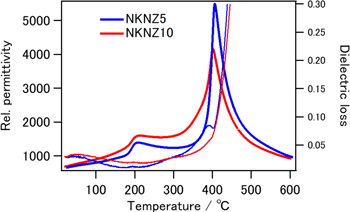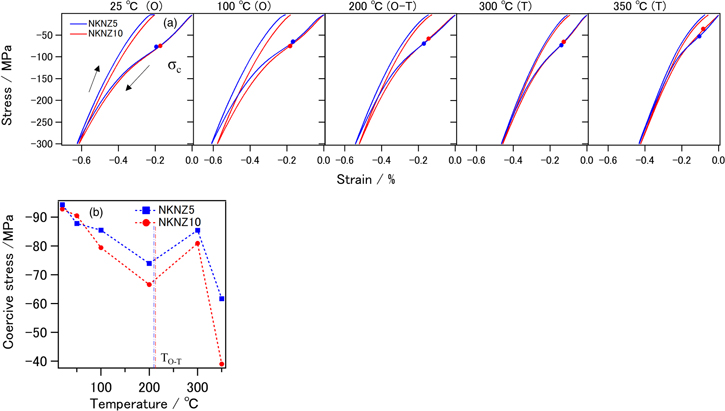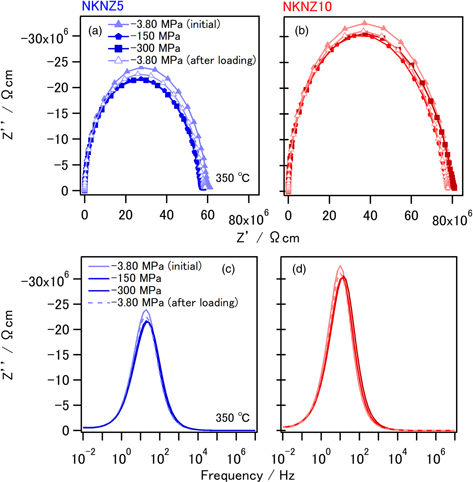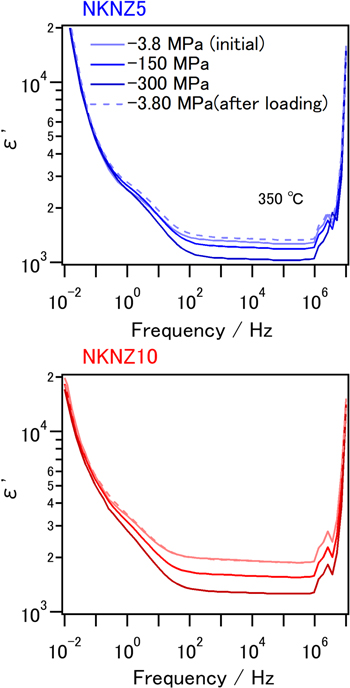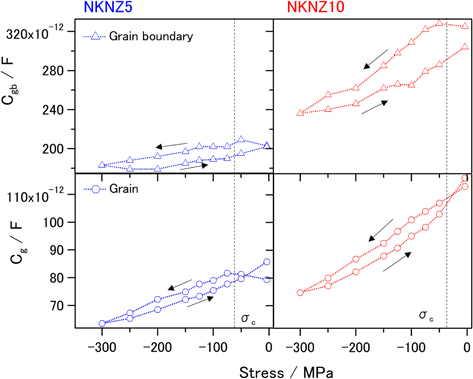Abstract
In this study, stress-dependent impedance spectra were characterized as a function of uniaxial compressive stress up to –300 MPa for Zr-doped (Na0.5K0.5)(Nb1−x/125Zrx/100)O3−δ (x = 5, 10 mol%). This allowed for the evaluation of the stress-induced changes in the grain and grain boundary capacitance. The grain capacitance from equivalent circuit fitting exhibited decreasing behavior with increasing uniaxial compressive stress increased, which is attributed to hindered domain wall movement reducing the extrinsic contributions. Interestingly, NKNZ10 showed a more significant degradation in grain capacitance than NKNZ5. One possible explanation is the difference in oxygen vacancies, and by extension defect dipoles, when introducing Zr into the lattice. As such, this study reveals the amplifying effect of oxygen vacancies to the mechanical suppression of domain wall movement.
Export citation and abstract BibTeX RIS

Content from this work may be used under the terms of the Creative Commons Attribution 4.0 license. Any further distribution of this work must maintain attribution to the author(s) and the title of the work, journal citation and DOI.
1. Introduction
Ferroelectric materials based on the perovskite structure (ABX3) have gained significant importance as a class of materials due to their diverse functional properties, including ferroelectricity
1) and photovoltaic capabilities.
2) Ferroelectricity is the process of reorienting the unit cell's spontaneous polarization to a more energetically advantageous crystallographic alignment. This phenomenon occurs when a ferroelectric material is subjected to an external electric field large enough to induce the movement of domain walls. Consequently, the ferroelectric properties are closely linked to the mobility of the domain walls. Due to the simplicity of the perovskite structure, the domain wall mobility, and subsequently the functional properties, can be easily adjusted through relatively minor substitutions of the A-site or B-site ions. For instance, Li-Al co-doped BaTiO3 (BT) exhibits a largely temperature-independent piezoelectric charge coefficient  (∼300 pC/N) and quality factor (∼2000) in the range of RT.
3) Likewise, Mn-doped (Pb0.92Sr0.08)(Zr0.533Ti0.443Nb0.024)O3 showed an increased mechanical quality factor (∼700) while maintaining a sufficiently high
(∼300 pC/N) and quality factor (∼2000) in the range of RT.
3) Likewise, Mn-doped (Pb0.92Sr0.08)(Zr0.533Ti0.443Nb0.024)O3 showed an increased mechanical quality factor (∼700) while maintaining a sufficiently high  (∼500 pC/N).
4) In both studies, it is understood that acceptor doping with lower valence ions generated oxygen vacancies and, by extension, defect dipoles. The resulting interaction with these defect dipoles alters the mobility of domain walls, ultimately leading to the phenomenon known as the ferroelectric hardening effect, where the domain walls are stabilized.
4)
(∼500 pC/N).
4) In both studies, it is understood that acceptor doping with lower valence ions generated oxygen vacancies and, by extension, defect dipoles. The resulting interaction with these defect dipoles alters the mobility of domain walls, ultimately leading to the phenomenon known as the ferroelectric hardening effect, where the domain walls are stabilized.
4)
Similar to the realignment of the spontaneous polarization via an electric field, reorientation of the spontaneous strain via an external mechanical field is also possible, referred to as ferroelasticity. 5,6) The mechanical reorientation of domain walls, similar to the hardening effect, can have a significant impact on the observed dielectric and piezoelectric properties by limiting domain wall mobility. 7,8) For instance, Schader et al. proposed that the decrease in permittivity of BT ceramics via mechanical stress is partly attributed to domain wall clamping. 8) Furthermore, via the introduction of ZnO into a 0.94(Na1/2Bi1/2)TiO3-0.06BaTiO3 (NBT-6BT) matrix, internal stresses caused by a thermal mismatch during the sintering process led to a hardening effect as well. 9) As such, acceptor-doping as well as mechanical stress, can change the overall electrical properties. When combining acceptor-doping and mechanical stress, Zhang et al. showed that Pb(Zr,Ti)O3 (PZT) improved dielectric and piezoelectric properties at uniaxial stress levels of approximately −30 MPa. 10) Similar results have been obtained by Schader et al. 11) showing that mechanical stress can increase the piezoelectric response in acceptor doped PZT through the interaction with the defect dipole-induced internal bias field. It should be highlighted that beyond the optimization stress levels, a degradation of the small-signal responses was observed. 10,11)
Observation of dielectric properties can provide information about the domain mobility during mechanical loading, in addition to information on how acceptor dopants change this behavior. However, the dielectric response of ferroelectric ceramics are a superposition of the grain (bulk) and grain boundary response. To gain a comprehensive understanding of the impact of domain wall mobility on the overall dielectric properties, it is necessary to evaluate the contributions of the grain response. In this regard, impedance spectroscopy emerges as a useful technique that enables the characterization of frequency-dependent electrical properties in polycrystalline microstructures. 12) Impedance measurements are made over a broad frequency range, and the different regions of the material, e.g. grains and grain boundaries, are characterized according to their electrical relaxation times or time constants. 12) As such, Nishiyama et al. were able to investigate the contribution of domain wall motion from the impedance spectra by identifying the nonlinear increase of grain capacitance to the electric field dependence of the dielectric constant in Mn-doped NKN. 13) Moreover, based on impedance spectroscopy studies conducted by Liu et al. the relationship between the contribution of dc conduction and the overall dielectric relaxation in NKN-based ceramics is connected to two phenomena. The long-range movement of doubly-ionized oxygen vacancies and the short-range jumping of localized oxygen vacancies. 14) However, there is limited knowledge on how mechanical stress influences the grain (bulk) and grain boundary response or how the hardening effect changes this behavior. Therefore, further investigation is needed in this area.
In order to investigate the impact of stress, this study will focus on NKN-based ceramics. These materials exhibit a high Curie point above 400 °C, making them promising environmentally friendly materials for high-temperature applications. 15) In a recent study, Zr-doped NKN achieved improved electrical properties due to the controlled fine microstructure (average grain size of approximately 2 μm) without abnormal grain growth. 16) Tanaka et al. observed similar materials and found indications of defect dipoles from the increase of coercive field and the peak shift in soft X-ray emission spectra. 17) The presence of defect dipoles in Zr-doped NKN ceramics effectively reduced the occurrence of independent oxygen vacancies, thereby improving fatigue resistance and resulting in ferroelectric hardening. 17) This improvement can be attributed to the ability of defect dipoles to deplete domain wall mobility, consequently impeding domain switching and promoting the stabilization of the domain structure. 4)
Despite several investigations on Zr-doped NKN, there are no studies on the mechanical properties. In order to receive a better understanding of the influence compressive stress have on the dielectric response, in situ stress-dependent impedance spectroscopy. These measurements reveal the influence of mechanical stress on the dielectric properties of grain and grain boundary. Furthermore, the influence of acceptor doping on stress-dependent dielectric properties is observed.
2. Experimental method
Polycrystalline ceramics of Na0.55K0.45Nb1-0.8x Zrx O3 + 0.2 mol% MnO (x = 0.005 and 0.010,) were synthesized via the mixed-oxide method. These compositions are referred to as NKNZ5 and NKNZ10, respectively. Starting powders of K2CO3(3N) Na2CO3(3N) (Rare Metalic Co., LTD.), and Nb2O5(3N) (Taniobis GmbH), ZrO2(3N) (Kishida Chemistry) were stoichiometrically weighed and combined. The raw powders underwent wet milling for 16 h using ZrO2 ball media (5 mm diameter) in anhydrous acetone and were subsequently calcined at 910 °C for 10 h in air. Following the calcination, the powders were subjected to another 16 h milling process. Afterwards, 0.2 mol% MnO were added to both ceramics to effectively suppress the leakage current. 18) The disks were then cold-isostatically pressed at 300 MPa for 3 min. The sintering temperature was 1140 °C and 1150 °C for NKNZ5 and NKNZ10, respectively. The holding time at maximum temperature was 2 h, and the heating and cooling rate was 5 °C min−1. To ensure random domain distribution before each measurement, the samples were annealed at 600 °C for 2 h with a heating and cooling rate of 5 °C min−1. Information about the microstructure can be found elsewhere. 17) Both compositions showed a monomodal grain size distribution with an average grain diameter of about 1 μm. In the same study, undoped NKN has shown a broad grain size distribution and average grain size of approximately 10 μm. Since the grain size distribution is essential for the impedance spectroscopy, the focus was on the samples with equal grain size distribution, i.e. NKNZ5 and NKNZ10.
The ferroelastic behavior was characterized by measuring the macroscopic stress–strain curves during uniaxial compression (Zwick/Roell Z030, Germany). Prior to loading the sample with uniaxial compressive stress at a rate of 3 MPa s−1 up to a maximum stress of −300 MPa, a preload of −4 MPa was applied. Additional information regarding the experimental setup are available elsewhere.
19) Impedance spectra between 10 mHz and 10 MHz were gathered with a frequency response analyzer (Novocontrol Technologies GmbH, Germany). An AC electric field with amplitude ±0.167 V mm−1 was applied parallel to the applied compressive stress. The spectra were gathered at 350 °C, in 25–50 MPa stress intervals until the maximum stress of −300 MPa was achieved, which was carried out on a load frame (5967 Instron GmbH, Germany). To analyze the resulting impedance spectra, the bricklayer model
20) was used. It should be noted, however, that the model presumes regular, exactly cubic, isotropic grains of the same size, linear contacts between the grains, and unchanging grain boundary properties. In a previous study, the average grain size of Zr-doped NKN was estimated to be 2 μm with homogenous distribution.
17) Since a homogenous microstructure is present in our material, the bricklayer is a reasonable approximation.
17) To describe the ceramics, an equivalent circuit comprising two serial R-CPE elements was used. In this context, R denotes a resistor element, while CPE represents a non-ideal capacitor element with a frequency-dependent response, often referred to as a constant phase element. The use of a CPE is justified in explaining the shape of the depressed complex plot, as the materials deviate from ideal capacitors.
21) The two R-CPE elements represent the responses of the grain and grain boundary, where  is capacitance,
is capacitance,  is resistance,
is resistance,  is CPE, and a relaxation distribution parameter
is CPE, and a relaxation distribution parameter  of grain and grain boundary can be estimated (
of grain and grain boundary can be estimated (




 )
22)
)
22)

where  describes the deviation from an ideal capacitor by denoting a criterion of how far the arc is depressed below the real impedance axis.
describes the deviation from an ideal capacitor by denoting a criterion of how far the arc is depressed below the real impedance axis.
3. Results and discussion
From RT, undoped (Na0.5K0.5)NbO3 ceramics transition from orthorhombic (O, Amm2) or monoclinic (M, Pm)  tetragonal (T, P4mm)
tetragonal (T, P4mm)  cubic (C, Pm
cubic (C, Pm
 m) at approximately 220 °C, and 420 °C, respectively.
23,24) For the purpose of identifying the phase transition temperatures, temperature-dependent permittivity was characterized for NKNZ5 and NKNZ10 (Fig. 1). In both compositions, two distinct dielectric anomalies are apparent, indicating the occurrence of two structural phase transitions. The initial anomaly at 210 °C for NKNZ5 and 213 °C for NKNZ10 corresponds to the orthorhombic to tetragonal phase transition (TO–T
). This transition was identified using the line-intersect method. The second anomaly, observed at 406 °C and 401 °C for NKNZ5 and NKNZ10, respectively, represents the Curie point. In undoped NKN, the TO–T
and Curie point are found at approximately 220 °C and 420 °C,
23,24) showing that the introduction of Zr shifted both temperatures to lower values. A similar small reduction in phase transition temperature was also shown in Mn doped NKN, in which a 15 °C decline of TC
was observed for 0.5 mol% Mn.
25) Additionally, in La doped NKN, a more pronounced decrease in TC
of approximately 50 °C was observed when doping with 1.75 mol% La.
26)
m) at approximately 220 °C, and 420 °C, respectively.
23,24) For the purpose of identifying the phase transition temperatures, temperature-dependent permittivity was characterized for NKNZ5 and NKNZ10 (Fig. 1). In both compositions, two distinct dielectric anomalies are apparent, indicating the occurrence of two structural phase transitions. The initial anomaly at 210 °C for NKNZ5 and 213 °C for NKNZ10 corresponds to the orthorhombic to tetragonal phase transition (TO–T
). This transition was identified using the line-intersect method. The second anomaly, observed at 406 °C and 401 °C for NKNZ5 and NKNZ10, respectively, represents the Curie point. In undoped NKN, the TO–T
and Curie point are found at approximately 220 °C and 420 °C,
23,24) showing that the introduction of Zr shifted both temperatures to lower values. A similar small reduction in phase transition temperature was also shown in Mn doped NKN, in which a 15 °C decline of TC
was observed for 0.5 mol% Mn.
25) Additionally, in La doped NKN, a more pronounced decrease in TC
of approximately 50 °C was observed when doping with 1.75 mol% La.
26)
Fig. 1. Temperature dependence of permittivity and dielectric loss of NKNZ ceramics measured at 1 kHz.
Download figure:
Standard image High-resolution imageInterestingly, the difference in relative permittivity between NKNZ5 and NKNZ10 is more pronounced at elevated temperatures above the TO–T than below the TO–T . Similar anomalies were shown in similar NKN-based materials. 27,28) A possible explanation is the increased amount of oxygen vacancies. The higher concentration of Zr dopants promotes the occurrence of oxygen vacancies, which in turn become more mobile at elevated temperatures. 11,29) This enhanced mobility likely influences the behavior of domain walls within the material, leading to increased extrinsic contributions to the permittivity. Schader et al. 11) found in hard PZT two different switching steps in the temperature-dependent d33 measurements under compressive stress. Whereas at lower temperatures, oxygen vacancies were able to suppress domain wall motion, enhanced thermal energy at temperatures above approximately 150 °C allowed for increased domain wall motion. However, it is not clear if the defect dipoles were directly switched or indirectly through the local domains.
In order to see the impact of mechanical stress on the domain switching behavior, stress–strain curves were measured at several temperatures below the Curie point. Figure 2(a) illustrates the stress–strain curves of NKNZ ceramics characterized at 25 °C, 100 °C, 200 °C, 300 °C, 350 °C. During the application of mechanical stress, an initial linear elastic deformation is apparent until the critical stress, i.e. the coercive stress (σc ), is reached. Upon reaching σ c , nonlinear stress–strain behavior is observed as a result of ferroelastic domain wall motion. 30) While increasing the applied force further, the nonlinear strain component reaches saturation, resulting in a linear elastic response at compressive stresses well above the coercive stress. Upon unloading, the materials initially exhibit linear elastic behavior, which transitions to nonlinear stress–strain behavior with further unloading. This is caused by local electric and mechanical fields which induce domain backswitching. Notably, upon the withdrawal of the applied compressive stress, a remanent strain is observed, indicating that not all domains revert back to their initial orientation. It should be noted that there is no significant difference between NKNZ5 and NKNZ10 in the stress strain curve at lower temperatures. This can be related to the location of oxygen vacancies introduced by Zr doping. Within the microstructure, three relevant locations can be identified for charge carrier rearrangement, including oxygen vacancies: the bulk, grain boundaries, or domain walls. 31) Recent theoretical models reported that the clamping pressure from charged defects between domain walls is three orders of magnitude lower than from defects at the grain boundary. 32) Therefore, the degree of clamping pressure on the domain walls by Zr doping effect is expected to change, depending on the location. There is a possibility that defect dipoles by Zr doping are formed between domain walls, which led to weak clamping pressure, leading to minor differences in the ferroelastic response between NKNZ5 and NKNZ10. At RT, the remanent strain was determined to be −0.23% for NKNZ5 and −0.21% for NKNZ10. This remanent strain was significantly decreased at 350 °C, at which point the remanent strain was −0.074% and −0.055% for NKNZ5 and NKNZ10, respectively. Typically, higher temperatures are expected to decrease the energy threshold for domain switching, resulting in an increase in the observed remanent strain. 19,33) However, the tetragonal lattice distortion is reduced compared to the orthorhombic phase in NKN-based systems. 34) Previous studies on PZT have demonstrated a correlation between lattice distortion and remanent strain, 35) which is most likely the cause for the decrease in the current observation.
Fig. 2. (a) Stress–strain curve of NKNZ ceramics at varying temperatures, as well as (b) the relationship between coercive stress of NKNZ ceramics at elevated temperatures.
Download figure:
Standard image High-resolution imageFigure 2(b) illustrates the relationship between coercive stress and temperature. At RT, NKNZ5 and NKNZ10 showed values of –94.3 MPa and –92.8 MPa, respectively. Similar values have been found for undoped NKN. 34) By increasing the temperature, the coercive stress generally decreases because the energy barrier for domain wall movement is reduced, thus, enabling ferroelastic domain reorientation at lower stress levels. 19,33) This trend is observed before and after the respective TO–T , meaning at regions of similar crystal structure. However, at the respective phase transition temperatures, a noticeable increase in coercive stress occurred. Similar coercive stress increases around TO–T were reported in NKN ceramics and is attributed to changes in the lattice distortion. 34,36) For instance, Seo et al. found differences in the coercive stress when comparing rhombohedral and tetragonal PZT. 36) Additionally, mechanical softening at the TO–T was observed in BT, 37) which could be an additional effect for the observed changes in NKN around the TO–T .
NKNZ5 and NKNZ10 exhibit similar behavior in terms of temperature-dependent coercive stress, except for a significant divergence observed between 300 °C and 350 °C. As discussed earlier, this divergence can be attributed to the previously mentioned increased mobility of polar defects and domain walls. This has been indicated by the notable dielectric loss and permittivity differences between NKNZ5 and NKNZ10 at 350 °C (Fig. 1). Similar observations have been made in temperature dependent ferroelastic measurements on soft and hard PZT. 38) Here, the acceptor doped material showed a more significant reduction in the coercive stress with elevated temperature than the soft PZT.
For the purpose of investigating the domain wall mobility change due to uniaxial compressive stress, stress-dependent impedance spectra were measured. Since permittivity and ferroelastic measurements have suggested that materials deviate greatly, and exhibit the most significant effect at approximately 350 °C, this temperature was chosen for the subsequent measurements. Figures 3(a) and 3(b) illustrate the imaginary impedance against real impedance at 350 °C. Both compositions exhibit single semicircles in Nyquist plots owning to superimposed grain and grain boundary contributions. Here, the overall impedance of NKNZ10 was greater than the overall impedance of NKNZ5. In addition, Figs. 3(c) and 3(d) show the frequency-dependent imaginery part of impedance (Bode plot). This allows for the estimation of the relaxation frequencies ( ), where the relaxation frequency of NKNZ5 and NKNZ10 were 20 Hz and 10 Hz for −3.8 MPa (initial) state and 28 Hz and 14 Hz for −300 MPa state, respectively.
), where the relaxation frequency of NKNZ5 and NKNZ10 were 20 Hz and 10 Hz for −3.8 MPa (initial) state and 28 Hz and 14 Hz for −300 MPa state, respectively.
Fig. 3. Impedance spectra for NKNZ ceramics represented in Nyquist (a), (b), and Bode (c), (d) plot at 350 °C.
Download figure:
Standard image High-resolution imageConsidering that the samples have similar microstructure 17) and dimensions, changes to the overall impedance and relaxation frequency can only occur due to changes to the conductivity and dielectric response. Since previous permittivity measurements have shown that NKNZ10 has a higher value than NKNZ5 at 350 °C, the relaxation frequency should be lower. In addition, Yoon et al. revealed that acceptor (Mg) doping reduced the overall impedance spectra, especially grain conductivity in Mg-doped BT 39) due to a decrease in the resistivity. Whereas the relaxation frequency is indeed lower, the impedance showed the opposite trend for NKNZ5 and NKNZ10. As such, it seems that the introduction of Zr increased the overall resistivity of the material. Similar observations have been made on composite materials, such as YSZ/Al2O3 40,41) and NKN/Al2O3. 42)
Upon applying compressive stress, the overall impedance decreases while the relaxation frequency increases. Furthermore, these changes remain after unloading of the mechanical stress, leaving the electric properties in a remanent state similar to strain. Impedance spectra is influenced by several factors, such as grain size, 43) defect structure, 44) and domain structure. 12) Since uniaxial compressive stress does not influence grain size or relative density, it is more plausible that these changes are due to reorientation of ferroelastic domains and potentially polar defects.
The impedance spectra (Z' and Z'') include the resistance (R) and capacitance (C) effects of the electric circuit. In order to examine the impact of uniaxial stress on capacitance, the relationship between permittivity and frequency is illustrated in Fig. 4. The permittivity (ε') is calculated using Eq. (1):

where  is the angular frequency,
is the angular frequency,  and
and  are the capacitance of free space and the ceramics, respectively. At low frequencies, atoms and molecules have sufficient time to polarize and reorient themselves in response to the electric field, resulting in elevated values of the permittivity. However, as the frequency increases, the time available for the atoms and molecules to respond decreases, resulting in reduced polarizability and consequently decreasing permittivity. The significant increase at lower frequencies (10–2–10–1) compared to higher frequencies (106–107) can be associated with the vanishing of space charge polarization contribution.
are the capacitance of free space and the ceramics, respectively. At low frequencies, atoms and molecules have sufficient time to polarize and reorient themselves in response to the electric field, resulting in elevated values of the permittivity. However, as the frequency increases, the time available for the atoms and molecules to respond decreases, resulting in reduced polarizability and consequently decreasing permittivity. The significant increase at lower frequencies (10–2–10–1) compared to higher frequencies (106–107) can be associated with the vanishing of space charge polarization contribution.
Fig. 4. Permittivity as a function of frequency estimated from impedance spectra at 350 °C.
Download figure:
Standard image High-resolution imageWith the increase of applied uniaxial compressive stress, permittivity decreased proportionally for both NKNZ compositions for 100 Hz–1 MHz. The change in permittivity results from various factors, such as the reversible intrinsic converse electrostrictive effect, domain wall movement, and domain wall suppression. 45) Generally speaking, acceptor-doped materials have lower permittivity with low dielectric loss due to low domain mobility. 46) Nevertheless, NKNZ10 has a relatively greater permittivity in comparison with NKNZ5, as already suggested in Fig. 1. Besides domain wall mobility, the microstructure, such as grain size, 47) porosity, 48) and secondary phases, 49) can have some influence on permittivity. Nevertheless, both compositions exhibited the same microstructure. 17)
Figure 5 displays the uniaxial stress dependence of grain (bulk) and grain boundary capacitance at 350 °C. With the increase of uniaxial stress until –300 MPa, the grain capacitance decreased by 20% for NKNZ5 and 34% for NKNZ10, whereas the grain boundary capacitance decreased by 10% and 27%, respectively. Degradation of the permittivity has been observed previously in BT, 37) Ba(Zr0.2Ti0.8)O3–(Ba0.7Ca0.3)TiO3 (BCZT), 50) NBT-6BT, 51) and NKN-based 52,53) ceramics. In general, the domain wall mobility is reduced while the material is exposed to mechanical stress. 45)
Fig. 5. Grain and grain boundary capacitance versus uniaxial stress.
Download figure:
Standard image High-resolution imageAdditionally, sufficiently large mechanical stress can result in the change of the domain structure, which which is demonstrated by the nonlinear behavior in the stress–strain curve (Fig. 2). In the case of a tetragonal crystal structure, this results in the reorientation of the c-axis and a-axis. This means that the c-axis will be predominately realigned perpendicular to the applied stress, resulting in the parallel reorientation of the a-axis. Consequently, the dielectric response will change due to the anisotropic dielectric properties of non-cubic phases in ferroelectric materials. Merz et al. observed that  (∼5000) was greater than
(∼5000) was greater than  (∼1000) at RT for BT single crystals.
54) This anisotropy in the dielectric properties is also expected in NKN ceramics since it exhibits a tetragonal phase at 350 °C. Since the material shows predominantly a-axis parallel to the measurement direction, an increase in the permittivity and subsequently capacitance would be expected. However, the results at elevated stresses suggest that domain wall clamping effects outweighed the permittivity increase, resulting in an overall decrease. The effect of the domain reorientation becomes visible at the remanent state, where domain clamping by external stresses is relieved. Here, both NKNZ ceramics, exhibited a greater value than in the initial state (Fig. 4).
(∼1000) at RT for BT single crystals.
54) This anisotropy in the dielectric properties is also expected in NKN ceramics since it exhibits a tetragonal phase at 350 °C. Since the material shows predominantly a-axis parallel to the measurement direction, an increase in the permittivity and subsequently capacitance would be expected. However, the results at elevated stresses suggest that domain wall clamping effects outweighed the permittivity increase, resulting in an overall decrease. The effect of the domain reorientation becomes visible at the remanent state, where domain clamping by external stresses is relieved. Here, both NKNZ ceramics, exhibited a greater value than in the initial state (Fig. 4).
These measurements further revealed the effect of acceptor doping on the stress-dependent capacitance change. NKNZ10 showed a more substantial decreasing effect than NKNZ5. This can be due to the difference in concentration of Zr-doped NKN ceramics. Despite the limited solubility of Zr in (Na, K)NbO3, resulting in Zr4+ occupying the Nb5+ sites within the crystal lattice, NKNZ10 is anticipated to exhibit a higher quantity of oxygen vacancies/defect dipoles because of the valence disparity between Zr4+ and Nb5+ ions. It should be noted that in NKN ceramics a baseline of oxygen vacancies have already been introduced via alkali metal (Na, K) volatilization during sintering. 55) Furthermore, the addition of Mn occupying the B-site, forms similar defects as Zr4+. Nevertheless, both NKNZ compositions (NKNZ5, NKNZ10) exhibit most likely the same degree of alkali metal volatilization and added Mn. Thus, major differences in the behavior are most likely from the introduction of Zr into the B-site.
Additionally, oxygen vacancies/defect dipole may accelerate domain pinning effectively, causing a stronger capacitance reduction in NKNZ10. Notably, quenching experiments on hard PZT have shown that randomly distributed defects do not hinder domain wall motion, in contrast to aligned defects. 11,56) However, Warren et al. proposed that defect dipoles in the polycrystalline lattice do not perfectly align with the electric field direction. Instead, they are more likely to exhibit a "conical" distribution or alignment relative to the applied electric field, attributed to the random crystallographic orientation of the grains. 57) Similarly, it is expected that this realignment of defect dipoles occurs when uniaxial compressive stress is applied, whether directly or indirectly. 58) Prior to the application of mechanical stress, defect dipoles are randomly distributed. Only after the mechanical stress is applied, defect dipoles move perpendicular to the applied stress directly or indirectly, thus resulting in the alignment of defect dipole, which inhibits domain pinning significantly in NKNZ10. In other words, stress can bring about defect dipole alignment, followed by effective domain pinning (ferroelectric hardening), leading to stronger capacitance reduction in NKNZ10.
Another reason can be considered in grain boundary capacitance. Araki et al. suggested that the conductivity of yttrium stabilized zirconia decreased with increasing compressive stress, which is related to the fact that compressive stress could hinder oxygen diffusion in the compressive direction. 59) It is possible that compressive stress could reduce ionic diffusion, resulting in the grain boundary capacitance decrease during compression. This stress-induced change in ionic conductivity, i.e. vacancy mobility, however, is of anisotropic nature. 60,61) Consequently, the application of mechanical stress may have facilitated the migration of oxygen vacancies to the grain boundary, thereby influencing the concentration of vacancies at that location. Phase field modeling studies conducted on PZT thin films have indicated that under the influence of a tip load, oxygen vacancies undergo lateral relocation (near the film surface) away from the tip. 62) This relocation process leads to the formation of a region depleted of vacancies beneath the tip, primarily caused by the compressive strains induced by the tip, which are unfavorable for vacancy formation. 62) Since the grain boundary requires more energy for the oxygen vacancies to migrate, the accumulation of defects at the grain boundary area, and subsequent change in the capacitance are plausible. Saremi et al. have shown that the reduction of domain wall mobility depends on the size of the defect clusters in PZT thin films. 63)
4. Conclusions
This study conducted a comprehensive investigation into the impact of uniaxial compressive stress on the impedance response of Zr-doped NKN-based materials. It was observed that the dielectric response of the grains (bulk) and grain boundaries decreased with increasing uniaxial compressive stress, whereas the relaxation frequency increased. Importantly, higher Zr concentration in NKNZ10 displayed a stronger decrease in grain capacitance than NKNZ5, which showed a 34% decrease for NKNZ10 and a 20% decrease for NKNZ5. It is expected that NKNZ10 has a larger amount of oxygen vacancies and subsequently defect dipoles due to the valence difference between Zr4+ and Nb5+ ions.
Acknowledgments
This study was supported by JSPS Japanese-German Graduate Externship (Grant No. 2019/R1), JSPS Grants-in-Aid for Scientific Research B (Grant No. 22H01773), and Erasmus+ grant. KGW gratefully acknowledges financial support from the Deutsche Forschungsgemeinschaft under GRK2495/F.


